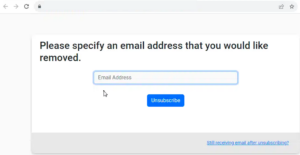The “Non-Subscribe” Attack: How ConcealBrowse Shields the Human Layer
The Deceptive Face of “Unsubscribe”
It’s no longer a surprise that the cyber threat landscape is continuously evolving, and cybercriminals are relentlessly innovating ways to infiltrate and exploit unsuspecting users. The most recent deceptive method brought to our attention is the “Non-Subscribe” attack by our partner mSOC. This ploy deceives users by providing an “Unsubscribe” button in spam emails, drawing them into a trap under the facade of halting unwanted communications.
Understanding the “Non-Subscribe” Attack
The Deceptive Email: Users receive a spam email, often with a subject line that’s attention-grabbing or concerning. While the topic of the email might seem irrelevant, the purpose isn’t the content itself, but the “Unsubscribe” button embedded within.
The Trap: Clicking on “Unsubscribe” redirects users to a web page. This page may be eerily identical or closely resemble a legitimate-looking platform, as seen in the shared screenshot. Unsuspecting users, believing they are on a genuine page, enter their email address to unsubscribe.

Figure 1: The Suspicious Unsubscribe Redirect
The Motive: Contrary to what one might think, these users never subscribed to the emails in the first place. By entering their email address, they inadvertently validate their email address for cybercriminals. Moreover, the “Unsubscribe” button isn’t just for email harvesting – it has been leveraged for other mischievous activities as well.
In the case of this attack, an examination from mSOC of the Proofpoint log entry marked “SPAM” affirms the malicious nature of such emails. The payload URL embedded within these emails further underscores the need for caution.

Figure 2: Conceal’s Analysis of the Site in Question
ConcealBrowse: Your Protection Against Deceptive Tactics
Now, while technical solutions to detect and prevent such threats are paramount, it’s equally crucial to shield the human layer – the end-users. This is where ConcealBrowse steps in.
Real-time Alerts: If a user accidentally clicks on a deceptive link, ConcealBrowse offers real-time alerts, warning them about the potential threat while proactively isolating it in an environment clear of the organization’s network.
Layered Security: By integrating machine learning algorithms into the AI-powered detection and prevention engine, ConcealBrowse identifies and blocks malicious sites and payloads, protecting users even if they mistakenly land on risky sites.
Human-Centric Design: Recognizing that humans are the most vulnerable link in the security chain, ConcealBrowse has been designed keeping the user in mind. Its intuitive interface, combined with its potent backend security, ensures that users feel protected without feeling overwhelmed.
Final Thoughts
In the ongoing battle against cyber threats, it’s not enough to have just technical solutions in place. Protecting the human layer, the most targeted and vulnerable layer, is of utmost importance. The “Non-Subscribe” attack is just a glimpse into the deceptive methods employed by cybercriminals. With ConcealBrowse, you’re not just relying on technology to keep threats at bay; you’re empowering every individual to be a formidable line of defense against these ever-evolving threats.





